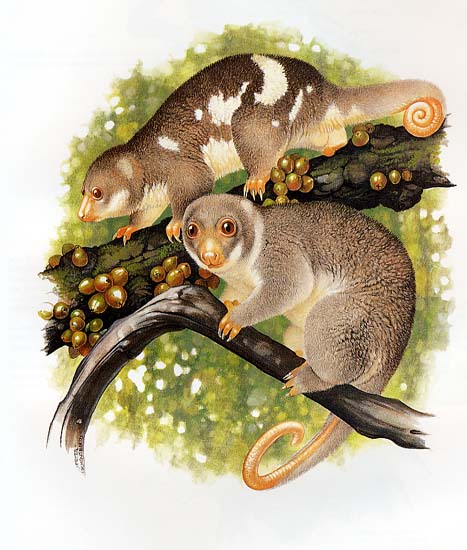[Recent Entries][Archive][Friends][User Info]
| January 31st, 2013 | |||||||||||||||||||||||||||||
|---|---|---|---|---|---|---|---|---|---|---|---|---|---|---|---|---|---|---|---|---|---|---|---|---|---|---|---|---|---|
| 04:17 pm [industrialterro] [Link] |
Bolodon Bolodon is a genus of extinct mammal from the Lower Cretaceous of Europe, and possibly the Upper Jurassic of North America. It was a member of the extinct order of Multituberculata and lived at the same time as dinosaurs. It is placed in the suborder Plagiaulacida and family Plagiaulacidae. The genus Bolodon was named by Owen R. in 1871. Material has also been reported from the Upper Jurassic Morrison Formation of North America. Some authors ascribe this genus to its own family, Bolodontidae. The species Bolodon crassidens is known from fossils of the Lower Cretaceous of England, in Durlston Bay, Dorset. Possible specimines also come from Spain. Fossils of the species Bolodon minor, aka. Plioprion minor, have been found in the Lower Cretaceous of Durlston Bay, Dorset. Plioprion (Cope, 1884) is probably synonymous with Bolodon. The species Bolodon osborni was named by Simpson G.G. in 1928. Fossils have been found in the Berriasian (Lower Cretaceous) of Durlston Bay, Dorset. Многобуго́рчатые (Multituberculata) — вымерший отряд древних млекопитающих (инфракласс Аллотерии (Allotheria), отряд Multituberculata). Название происходит от формы коренных зубов, на которых были расположены многочисленные бугорки. Внешне похожие на грызунов, они возникли в середине юрского периода и вымерли в раннем олигоцене. Были распространены только в Северном полушарии (праматерик Лавразия). The multituberculates had a cranial and dental anatomy similar to rodents, with cheek-teeth separated from the chisel-like front teeth by a wide tooth-less gap (the diasteme). Each cheek-tooth displayed several rows of small cusps (or tubercles, hence the name) that operated against similar rows in the teeth of the jaw. As in modern rodents, this masticatory apparatus formed an efficient chopping device. During the Cretaceous and Paleocene, the multituberculates radiated into a wide variety of morphotypes, including the squirrel-like arboreal ptilodonts. The peculiar shape of their last lower premolar is their most outstanding feature. These teeth were larger and more elongated than the other cheek-teeth and had an occlusive surface forming a serrated slicing blade. Though it can be assumed that this was used for crushing seeds and nuts, it is believed that most small multituberculates also supplemented their diet with insects, worms, and fruits. A ptilodont that throve in North America was Ptilodus. Thanks to the well-preserved Ptilodus specimens found in the Bighorn Basin, Wyoming, we know that these multituberculates were able to abduct and adduct their big toes, and thus that their foot mobility was similar to that of modern squirrels, which descend trees head first. In Europe another family of multituberculates were equally successful—the Kogaionidae, first discovered in Haţeg, Romania. They also developed an enlarged blade-like lower premolar and the Hainina, the most successful genus, was originally believed to be a ptilodont. However, more detailed analysis of this genus revealed a smaller number of dental cusps and a retained fifth premolar—a unique combination of primitive and advanced features indicating that Hainina were related to some Jurassic genera and that enlarged, blade-like premolar were acquired independently in Europe and North America. Another group of multituberculates, the taeniolabids, were heavier and more massively built and could reach the size of a modern beaver; indicating they lived a fully terrestrial life. They reached their highest diversity in Asia during the late Cretaceous and Paleocene, which suggests they originated from there. The structure of the pelvis in the Multituberculata suggests that they gave birth to tiny helpless young, similar to modern marsupials. About 80 genera of Multituberculata are known, including Lambdopsalis, Ptilodus and Meniscoessus. In the northern hemisphere, during the late Cretaceous, more than half of typical land mammalian species were multituberculates.
Аллотерии (Allotheria — буквально «другие звери», от греч. αλλός, «другой» и θήριον, «дикое животное») — успешная ветвь (подкласс) мезозойских млекопитающих. Наиболее важной характеристикой данного подкласса было наличие нижних коренных зубов, снабжённых двумя продольными рядами бугорков. В состав аллотериев входил весьма успешный для своего времени отряд многобугорчатые (Multituberculata), и возможно, также отряды харамиидов (Haramiyida) и загадочных гондванатериев (Gondwanatheria). Аллотерии имели узкий таз, что свидетельствует о том, что их детёныши рождались мелкими и беззащитными, как у современных сумчатых. Отниэл Марш, первым выделивший аллотериев в 1880 году, рассматривал их как отряд в составе сумчатых. В 1997 году Маккенна и Белл пересмотрели классификацию, выделив их как инфракласс. Териообразные (Theriiformes, Rowe, 1988; McKenna & Bell, 1997) — в альтернативной расширенной классификации, подкласс млекопитающих, к которому относят всех живородящих (включая человека), а также ископаемые находки живородящих млекопитающих, не относимых ни к плацентарным, ни к сумчатым. По молекулярным данным, разделение с однопроходными произошло примерно 217 ±31 — 231 ±24 миллиона лет назад. Подкласс состоит из трёх инфраклассов — голотерии, аллотерии и триконодонты.
Tags: Вымершие млекопитающие, Юра, аллотерии, мультитуберкуляты, териообразные | ||||||||||||||||||||||||||||
| Comments | |||||||||||||||||||||||||||||
этот хороший но его жиды с крокодилами заебали поэтому печальный такой вот до чего вы живёлу довели (Reply to this) (Thread)
а смотри какими глазами он смотрит на то, шо жыды вокруг вытворяют
Что же они вытворяют? (Reply to this) (Parent) | |||||||||||||||||||||||||||||
